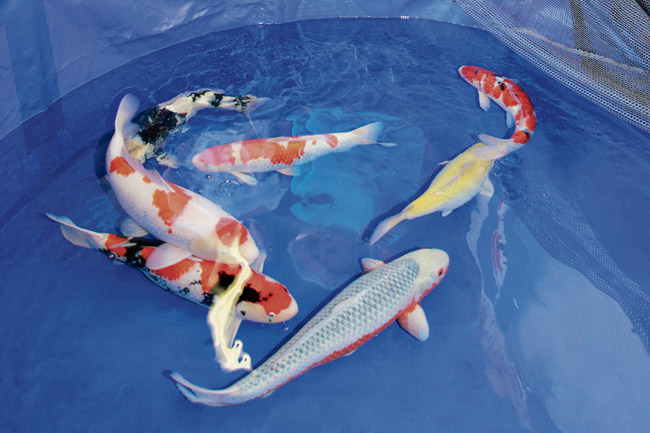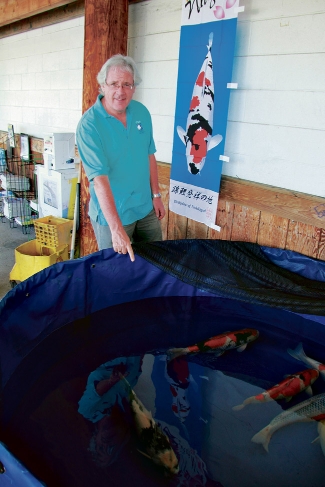Art That Swims
Maybe they need koi ponds at the Hawaii State Capitol. Anywhere there is a lot of bickering and posturing there is a lot of stress. How can our leaders find respite and calm from all that hot air?
The Aloha Koi Appreciation Society (AKAS) recommends watching fish swim around a tranquil garden pond. In time for its annual Aloha Koi Show, we are reminded that contemplation of fish in an aquarium or pond reduces levels of stress and anxiety. If there’s a choice of fish to watch, beautiful koi (carp) would top the list.
Koi are best viewed from the top, as opposed to tropical saltwater fish that are best viewed from the side. The fresh-water creatures that resemble silk brocade fabric are a feast for the eyes, mesmerizing spectators with flashes of color and patterns.
Someone who appreciates the scientific and aesthetic aspects of koi is Andrew Rossiter, director of Waikiki Aquarium and chairman of the eighth annual Aloha Koi Show and Japan Nishikigoi Expo. Rossiter was instrumental in bringing the event to Waikiki three years ago.
The AKAS-sponsored show is an opportunity to learn about the flamboyant ornamental fish that are highly prized by European and Asian breeders. The show is Saturday, Feb. 16, 9 a.m. to 4:30 p.m., and Sunday, Feb. 17, from 9 a.m. to 2 p.m., at Waikiki Aquarium. Admission is free with aquarium admission ($9 general; $6 kamaaina).
Attractions include Japanese entertainment, keiki activities, crafters and educational seminars. AKAS members will be present to address the raising and care of carp, including the importance of filtration systems to keep pond water oxygenated and clear.
Rossiter has been a koi hobbyist since his boyhood in Wales, where he worked at a pet store and had 15 aquariums in the home cellar.
With more than 20 years of experience as a scientist, educator and administrator in Japan, Canada and Africa, Rossiter today directs the third oldest aquarium in the United States, which is a branch of the University of Hawaii.
He is surrounded during the day by 3,500-plus marine animals in exhibits representing more than 500 species of aquatic animals and plants. At the end of the day, he relaxes at his Waialae-Iki home with more fish, having a self-built rock garden and koi pond.
“It took me two years to convince my wife, Yoshiko, to convert our 22,000-gallon swimming pool into a fish pond,” Rossiter says, smiling.
She deserves a gold medal for spousal support, we suggest.
At the Aloha Koi Show, Rossiter brings the public together with fellow AKAS members and master koi breeders to share knowledge. It also is an occasion to view the state’s most exquisite koi specimens.
Chief judge for the koi competition is Mitsumori Isa of Isa Koi Farm in Niigata, one of Japan’s foremost breeders. Koi specialists Mamoru Kodama of Miyoshiike Co. and Taro Kodama of Kodama Koi Farm in Mililani also will be at the show.
Explaining nishikigoi, as koi is known in Japan, Rossiter states, “The origin goes back about 200 years ago when magoi (black carp) of Central Asian and Persian origin was cultivated as a food source. Through a breeding process, some of the fish came up with red and blue mutations.”
Today, there are more than 100 color varieties, with each koi being unique. Like fingerprints and snowflakes, no two are exactly alike.
Koi have vivid colors, and the red-and-white (Kohaku) variety is especially prized for symbolizing the colors of the Japanese flag.
“Koi transcends Western and Japanese culture,” Rossiter observes. “The uniquely Japanese concept, a living art form, has been adopted throughout the world.”
For beginning hobbyists, he advises learning all one can from books and experts before digging up the backyard to make a pond.
“I learned everything I know through making mistakes,” says Rossiter, who emphasizes that it’s important to learn about quarantining fish, disease and treatment, proper feeding and water filtration.
“Don’t shortchange yourself on the filtration system,” he adds. “It is foolish to spend a lot on the fish and the pond, and less on the filtration system.”
Speaking of price, koi prices range from cheap ($5-$10) for small, common varieties to luxurious ($500-$10,000 each). For the serious collector, a $10,000 carp would be considered “peanuts,” according to Rossiter. Prize fish can cost $250,000-$300,000. Part-cash, part-koi trade deals are common among breeders.
But if you’re a fish trader, would you know what to look for and how to negotiate a good deal?
Networking at the Aloha Koi Show is the best way to fish for knowledge. It’s the ultimate consumer and trade show for koi. Yes, you can buy koi there, too.
If we’ve baited your interest, don’t be coy.
Make your way, like the mighty swimming koi, to Waikiki Aquarium Feb. 16 and 17.
Wear a colorful brocade happi coat or kimono if you like, to see if you can upstage the colorful koi.
Our money’s on the koi.







